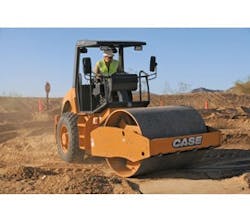By: John L. Nieber, P.E., P.H., Ph.D., Bradley J. Hansen and John Siekmeier, P.E.
In the construction of paved roads, one of the most important design aspects is the compaction of the subgrade material.
The specification for compaction of the subgrade materials has conventionally been set based on the Proctor compaction test (AASHTO T99) conducted on a particular subgrade material. The specification is given in terms of (optimum) moisture content at which the maximum density is achieved.
The problem with the AASHTO T99 test is the need to measure the bulk density and the moisture content of a compacted subgrade to determine whether it matches the prescribed values for the particular subgrade materials. Methods for making such measurements include gravimetric sampling with oven drying of the sample, or the use of a nuclear density gauge to measure both the moisture content and the dry bulk density. The gravimetric method is labor intensive and requires significant time for the samples to dry, a luxury not available to the construction inspector during construction operations. The nuclear gauge is capable of providing both moisture content and dry bulk density quickly, but growing concerns over the hazards associated with using the instrument and containing its radioactive sources have led to restricted use or eliminating its use altogether in some states. As a result there is now a national effort to develop alternatives.
What are the different methods of compaction?
Several recent projects in the U.S. have evolved out of the interest of developing alternatives to the nuclear gauge. One such project was recently completed by researchers at the University of Minnesota in collaboration with the Minnesota Department of Transportation (MnDOT). In this project, which was funded by the MnDOT, four alternative methods for measuring moisture status of soil samples were evaluated to determine their ability to measure water content of soils compacted with the AASHTO T99 test procedure. The devices for making the measurements included the DOT600 instrument, a product of Campbell Scientific; the WP4C Dewpoint Potentiometer, a product of Decagon Corp.; a heat pulse sensor; and an exudation test instrument.
The DOT600 instrument measures the volumetric moisture content of a sample using the principle of dielectric permittivity. The dielectric permittivity of a soil is related to the moisture content and salinity of the soil. The sample that is placed into the device is disturbed and is compressed to a standard compressed state (45-psi pressure) using a wrench to turn down a casing onto the enclosed sample. The device then measures the moisture content and the bulk density of the sample. The measurement takes only a few seconds. Preparation of the sample is relatively quick as well, but the sample is disturbed, not necessarily directly representing in situ conditions.
The WP4C measures the dewpoint potential of a sample of soil, and this is then related thermodynamically to the water potential of the soil sample. The instrument is suited to measuring water potential for potentials less than about -0.25 bars, so it will not provide accurate measurements for soils at moisture content above field capacity. Accurate measurements require 10- to 15-minute reading times. To operate the instrument a disturbed sample of the soil is placed in a dish that is then placed inside the instrument.
Heat pulse sensors can be designed with various configurations. The heat pulse sensor used in this project had a configuration that gives it the shape of a button, so it is referred to as the Button Heat Pulse Sensor (BHPS). Unlike many heat pulse sensors which typically are composed of rods or wires that penetrate the soil, the BHPS is composed of a heater ring mounted onto a plastic button, with a thermistor embedded through the center axis of the button. The sensor is pressed into the soil sample surface. A heat pulse is applied to the soil through the metal ring, and the temperature response in the soil is measured by the thermistor. The time to peak response and the magnitude of the peak response are related to the moisture content and characteristics of the compacted soil. Measurement time with the sensor is a few minutes.
The exudation device works by applying a variable force from an Instron device onto the surface of a confined compacted soil, and the pressure point where water first begins to exude out of the sample bottom is called the R-value. Many state DOTs use the R-value of the subgrade soil to design pavement thickness. Minnesota uses a design R-value of 240-psi exudation pressure for pavement design, so presumably the exudation pressure for a soil compacted at the optimum moisture content should be close to the 240-psi value. Measurement time with the instrument, not including sample preparation time, is 10 to 15 minutes.
Turn up the heat
In the University of Minnesota study three soil subgrade materials, differing from each other by texture and mineral composition, were used in the trias of the alternative testing methods. These soil materials are ones commonly used in Minnesota for roadway construction. The textures represented by these three materials were loam, silt and silty/clay. These soils were each compacted using the AASHTO T99 compaction procedure to determine the optimum moisture content/density for each. The four measurement methods were then applied to each of the compacted samples to determine their sensitivity to both dry bulk density differences as well as moisture content differences. In short, it was desired to know how accurately these devices would represent known soil-moisture conditions of the compacted samples.
Of these devices, the BHPS is the only one that is capable to make a measurement on compacted soils in situ. The other three methods require that a sample be collected from the compacted soil for testing.
Results with the various measurement devices can be summarized as the following:
- The factory-calibrated moisture content for the DOT600 did not fit well with the measured gravimetric moisture content of the soil samples. However, the output signal for the DOT600 was found to correlate well with the gravimetric moisture content of the compacted samples. This indicates that with calibration for each subgrade soil material the instrument should be able to measure the moisture content well. The instrument is built for use in the field or in the laboratory, so it is suited for field applications;
- With an independent laboratory procedure it was determined that the water potential for all the tested soils at AASHTO T99 optimum moisture content was in the range of -0.2 and -0.3 bars, just on the edge of the accuracy limit for the WP4C instrument. The results showed that the instrument was not capable of yielding accurate measurements of the water potential for compacted soils at the optimum moisture content or wetter, even for very long measurement times. For water contents below the optimum moisture content, the instrument was able to accurately reproduce the independently measured water potential. The instrument is best suited for use in clean, temperature-controlled environments, so it may not be a good choice for application to field conditions;
- The output from the BHPS, temperature rise as exemplified in Figure 3, was found to correlate well with the water content of the compacted samples. The relationship, however, is soil dependent and therefore it would be necessary to develop a calibration curve for each soil type. Such calibration should not be a problem since it could be determined ahead of time during AASHTO T99 testing of the soil prescribed for the particular construction site. The BHPS developed for the project is a prototype of what could be developed for general application. The prototype is not strong enough for the rugged conditions of the field, but with further developments the sensor could be designed to be more resilient to rugged field conditions; and
- For two of the soils the exudation pressure of 240 psi was reached for the soil compacted at a moisture content within 1% of the optimum moisture content. However, this was not the result for the silt soil. A much higher exudation pressure was required for the silt soil even when its compacted moisture content was 2% above the AASHTO T99 optimum.
Of the four methods used in this study the one with promise for in situ measurement of water content of compacted soils is the BHPS, but before it can be used in the field a rugged design would need to be developed. The DOT600 instrument is suited for use in the field, but would need to be made somewhat more rugged. With proper calibration it should provide accurate measures of water content. It does, however, require the use of a disturbed sample of soil. The exudation pressure test could be applied in the field if undisturbed cores can be collected from the compacted soil. However, additional experiments on more soils are needed for the exudation pressure to determine just how well the Minnesota design standard R-value (240 psi) corresponds to the AASHTO T99 optimum moisture content of subgrade soil materials.
The authors wish to acknowledge the MnDOT for sponsorship of the project from which the results presented in this article are based, and the Center for Transportation Studies at the University of Minnesota for project administration. The link to the technical report, “Alternative Devices for Measuring Soil Moisture,” associated with that project is http://www.dot.state.mn.us/research/TS/2013/201328TS.pdf. R&B
About The Author: Nieber is professor, Dept. of Bioproducts and Biosystems Engineering, at the University of Minnesota. Hansen is senior research scientist, Dept. of Bioproducts and Biosystems Engineering, at U-M. Siekmeier is senior research engineer at MnDOT.



